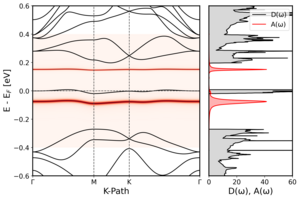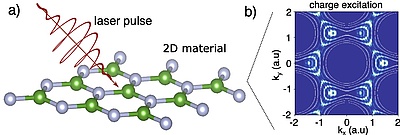Competing Quantum Phases in Transition-Metal Dichalcogenides
Transition-metal dichalcogenides (TMDs) are layered van der Waals materials that exist in a variety of polytypes. Particularly intriguing are group-V TMDs in the 1T polytype, such as 1T-TaS₂ and 1T-TaSe₂, which display a complex Star-of-David charge density wave and strong electronic correlation effects. In this research project, we explore the rich landscape of quantum phases that can emerge in these systems, with a special focus on superconducting and quantum spin liquid states. Our investigations include both 1T monolayers and multilayer structures, where stacking order and interface effects can play a significant role. To address the challenges posed by these strongly correlated materials, we employ and further develop state-of-the-art many-body techniques such as dynamical mean-field theory (DMFT) and the ab-initio dynamical vertex approximation (AbinitioDΓA).
Ultrafast, Light-Induced Electron Dynamics
The electronic structure and electron dynamics of solids can be probed and controlled using light. Capturing coherent electronic processes requires ultrafast timescales—femtoseconds (10-15) or attoseconds (10-18)—which can be achieved experimentally with ultrashort laser pulses. Theoretically, we simulate these phenomena from first principles using time-dependent density functional theory (TDDFT). Our current focus lies on nonlinear optical effects such as high-harmonic generation (HHG) and photocurrent generation in two-dimensional quantum materials. We aim to understand how HHG spectra and photocurrents encode information about the underlying electronic structure and dynamics, and we are exploring how strong light–matter interaction might even induce new quantum phases.

